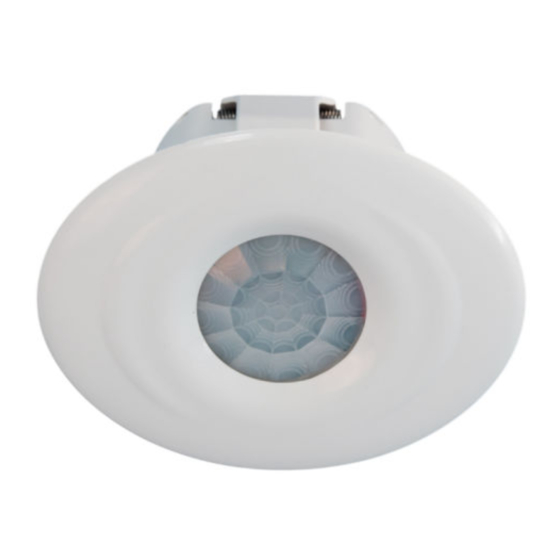
Table of Contents
Advertisement
Quick Links
Ceiling Mount PIR Occupancy Sensor Switch
(DC Power Supply)
Model #:
BRT-320
Features:
BRT-320 is a ceiling mount occupancy sensor switch which utilizes passive infrared (PIR) sensor
to detect the heat (in the form of infrared energy) from people moving within a space. It can
determine when a space is occupied and turns on or turns off the loads automatically. It has an
advanced micro controller unit and uses a proprietary signal processing technique to avoid false
triggers.
Instant on and adjustable delay off time from 2 minutes to 60 minutes;
Ambient light override. Automatically measures the ambient light level, and there is no
trigger on when it is above a light level which can be set by the user;
Easy installation onto the ceiling with or without a holder;
Good for 24V DC loads;
ABS-V0 flame resistance material; and
High quality build.
Fig. 1 and Fig. 2 show the front view and the back view of the BRT-320 PIR occupancy sensor
switch respectively.
Fig. 1
Front View
Product Description of BRT-320
Shenzhen Asia Bright Industry co., Ltd., Building 10, Asia Industrial Park, Gangtou, Bantian, Shenzhen, China.
www.a-brt.com. sales@a-brt.com.
© 2015 All rights reserved. Subject to change without notices.
Fig. 2
Back View
Page 1 of 6
Advertisement
Table of Contents

Subscribe to Our Youtube Channel
Summary of Contents for iPuray BRT-320
- Page 1 Good for 24V DC loads; ABS-V0 flame resistance material; and High quality build. Fig. 1 and Fig. 2 show the front view and the back view of the BRT-320 PIR occupancy sensor switch respectively. Fig. 1 Front View Fig. 2...
- Page 2 Fig. 3 shows the wiring diagram. Wiring must be done according to the diagram and the labelled ports of the switch. Installation Guide: There are two ways to install BRT-320 PIR sensor switches to the ceiling. Fig. 4 and Fig. 5 show the step-by-step installation instructions, respectively. Cautions: Avoid mounting the sensor switch close to air vents, as the vibration and air flow can reduce the effectiveness of the sensor switch;...
- Page 3 As shown in Fig. 4, a holder is attached to the ceiling using screws first. Then, the PIR sensor switch can be easily snapped into the holder. The holder is specially designed for BRT-320 sensor switch. Please talk to our sales representative when placing orders.
- Page 4 Installation without a Holder Operation Guide: BRT-320 PIR sensor switch needs a warm-up time about two minutes before it can operate properly. It has dip switches to adjust the delay off time, and has a precision tuning screw to adjust the ambient light override threshold, as shown in Fib.
- Page 5 Counter-clockwise to “+”: increase the threshold, so that the PIR triggers will be overridden in bright lighting condition; and Product Description of BRT-320 Page 5 of 6 Shenzhen Asia Bright Industry co., Ltd., Building 10, Asia Industrial Park, Gangtou, Bantian, Shenzhen, China.
- Page 6 Applications: BRT-320 ceiling mount PIR occupancy sensor can be used for automatically turning on and/or turning off various loads such as lights, fans, appliances, or other kinds of electrical equipment. BRT-320 PIR occupancy sensor switch is perfect for saving energy and bringing convenience and safety to our daily life and work.














Need help?
Do you have a question about the BRT-320 and is the answer not in the manual?
Questions and answers